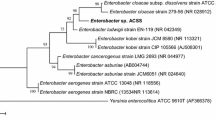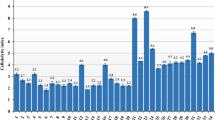Abstract
The Rhizopus microsporus var. microsporus biofilm was able to produce increased levels of an extracellular thermotolerant phytase using polyethylene and viscose as an inert support in both modified NBRIP medium and modified Khanna medium containing sugarcane bagasse as the carbon source. The enzyme production was strictly regulated by the phosphorus content with optimal production at 0.5 mM of sodium phytate and KH2PO4. The extracellular phytase, RMPhy1, was purified 4.18-fold with 4.78 % recovery using DEAE-cellulose and CM-cellulose. A single protein band with a molecular mass of 35.4 kDa was obtained when the samples were subjected to 10 % SDS-PAGE. The optimum temperature for activity was 55 °C and the optimum pH was 4.5. R. microsporus var. microsporus phytase exhibited high stability at 30 and 40 °C with a half-life of 115 min at 60 °C. The enzyme activity increased in the presence of Ca2+ and was inhibited by Zn2+, arsenate, and sodium phosphate. Phytase demonstrated high substrate specificity for sodium phytate with K m = 0.72 mM and V max = 94.55 U/mg of protein and for p-NPP with K m = 0.04 mM and V max = 106.38 U/mg of protein. The enzyme also hydrolyzed ATP, AMPc, glucose 6-phosphate, glucose 1-phosphate, and UDPG. This is the first report on phytase characterization delivered with biofilm technology. The properties of the enzyme account for its high potential for use in biotechnology and the possibility of application in different industrial sectors as feed in the future.





Similar content being viewed by others
References
Vance, C. P., Uhde-Stone, C., & Allan, D. L. (2003). Phosphorus acquisition and use: critical adaptations by plants for securing a nonrenewable resource. New Phytologist, 157, 423–447.
Yang, X. J., & Finnegan, P. M. (2010). Regulation of phosphate starvation responses in higher plants. Annals of Botany, 105, 513–526.
Rao, D. E. C. S., Rao, K. V., Reddy, T. P., & Reddy, V. D. (2009). Molecular characterization, physicochemical properties, known and potential applications of phytases: an overview. Critical Reviews in Biotechnology, 29, 182–198.
Yu, P., Wang, X.-T., & Liu, J.-W. (2015). Purification and characterization of a novel cold-adapted phytase from Rhodotorula mucilaginosa strain JMUY14 isolated from Antarctic. Journal of Basic Microbiology, 54, 1–11.
Greiner, R., Silva, L. G., & Couri, S. (2009). Purification and characterization of an extracellular phytase from Aspergillus niger 11T53A9. Brazilian Journal of Microbiology, 40, 795–807.
Hurrel, R. F., Reddy, M. B., Juillerat, M. A., & Cook, J. D. (2003). Degradation of phytic acid in cereal porridges improves iron absorption by human subjects. The American Journal of Clinical Nutrition, 77, 1213–1219.
Wyss, M., Brugger, R., Kronenberger, A., Rémy, R., Fimbel, R., Oesterhelt, G., Lehmann, M., & van Loon, A. P. G. M. (1999). Biochemical characterization of fungal phytases (myo-inositol hexakisphosphate phosphohydrolases): catalytic properties. Applied and Environment Microbiology, 65, 367–373.
Jr, M., Macedo, J. A., & Macedo, G. A. (2011). A new process for simultaneous production of tannase and phytase by Paecilomyces variotii in solid-state fermentation of orange pomace. Bioprocess and Biosystems Engineering. doi:10.1007/s00449-011-0587-y.
Guimarães, L. H. S., Terenzi, H. F., Jorge, J. A., & Polizeli, M. L. T. M. (2004). Characterization and properties of acid phosphatase with phytase activity produced by Aspergillus caespitosus. Biotechnology and Applied Biochemistry, 39, 1–7.
Azeke, M. A., Greiner, R., & Jany, K.-D. (2011). Purification and characterization of two intracellular phytases from the tempeh fungus Rhizopus oligosporus. Journal of Food Biochemistry, 35, 213–227.
Gaind, S., & Singh, S. (2015). Production, purification and characterization of neutral phytase from thermotolerant Aspergillus flavus ITCC 6720. International Biodeterioration & Biodegradation, 99, 15–22.
Shivanna, G.B., & Venkateswaran, G. (2014). Phytase production by Aspergillus niger CFR335 and Aspergillus ficuum SGA01 through submerged and solid-state fermentation. Scientific World Journal, article ID 392615, 1–6.
Gutiérrez-Correa, M., Ludeña, Y., Ramage, G., & Villena, G. K. (2012). Recent advances on filamentous fungal biofilms for industrial uses. Applied Biochemistry and Biotechnology, 167, 1235–1253.
Gamarra, N. N., Villena, G. K., & Gutierrez-Correa, M. (2010). Cellulase production by Aspergillus niger in biofilm, solid-state, and submerged fermentations. Applied Microbiology and Biotechnology, 87, 545–551.
Sato, V. S., Jorge, J. A., Oliveira, W. P., Souza, C. R. F., & Guimarães, L. H. S. (2014). Phytase production by Rhizopus microsporus var. microsporus biofilm: characterization of enzymatic activity after spray drying in presence of carbohydrates and nonconventional adjuvants. Journal of Microbiology and Biotechnology, 24, 177–187.
Khanna, P., Sundari, S. S., & Kumar, N. J. (1995). Production, isolation and partial-purification of xylanases from an Aspergillus sp. World Journal of Microbiology and Biotechnology, 11, 242–243.
Wiseman, A. (1975). Handbook of enzyme biotechnology (p. 148). Chichester: Wiley.
Vogel, H. J. (1964). Distribution of lysine pathways among fungi—evolutionary implications. American Naturalist, 98, 435–446.
Rizzatti, A. C. S., Jorge, J. A., Terenzi, H. F., Rechia, C. G. V., & Polizeli, M. L. T. M. (2001). Purification and properties of a thermostable extracellular β-D-xylosidase produced by the thermotolerant Aspergillus phoenicis. Journal of Industrial Microbiology and Biotechnology, 26, 156–160.
Nautiyal, C. S. (1999). An efficient microbiological growth medium for screening phosphate solubilizing microorganisms. FEMS Microbiology Letters, 170, 265–270.
Gulati, H. K., Chadha, B. S., & Saini, H. S. (2007). Production and characterization of thermostable alkaline phytase from Bacillus laevolacticus isolated from rhizosphere soil. Journal of Industrial Microbiology and Biotechnology, 34, 91–98.
Bradford, M. M. (1976). Rapid and sensitive method for quantitation of microgram quantities of protein utilizing principle of protein-dye binding. Analytical Biochemistry, 72, 248–254.
Laemmli, U. K. (1970). Cleavage of structural proteins during the assembly of the head of bacteriophage T4. Nature, 227, 680–685.
Lineweaver, H., & Burk, D. (1934). The determination of enzyme dissociation constants. Journal of the American Chemical Society, 56, 658–666.
Vohra, A., & Satyanarayana, T. (2003). Phytases: microbial sources, production, purification, and potential biotechnological applications. Critical Reviews in Biotechnology, 23, 29–60.
Kneipp, L. F., Rodrigues, M. L., Holandino, C., Esteves, F. F., Souto-Padrón, T., Alviano, C. S., Travassos, L. R., & Meyer-Fernandes, J. R. (2004). Ectophosphatase activity in conidial forms of Fonsecaea pedrosoi is modulated by exogenous phosphate and influences fungal adhesion to mammalian cells. Microbiology-Sgm, 150, 3355–3362.
Dick, C.F., Dos-Santos, A.L.A., & Meyer-Fernandes, J.R. (2011). Inorganic phosphate as na important regulator of phosphatases. Enzyme Research, article ID 103980, 1–7.
Zhu, X.-L., Zhang, L. H., An, L., Gao, X., & Wang, Y. (2014). Plant growth promoting activities of phosphate-solubilizing bacteria Acinetobacter calcoaceticus YC-5a and Enterobacter agglomerans KMC-7. Journal of Pure and Applied Microbiology, 8, 2613–2618.
Couto, S. R., Sanromán, M. A., Hofer, D., & Gübitz, G. M. (2004). Stainless steel sponge: a novel carrier for the immobilization of the white-rot fungus Trametes hirsuta for decolourization of textile dyes. Bioresource Technology, 95, 67–72.
Villena, G. K., & Gutierrez-Correa, M. (2006). Production of cellulase by Aspergillus niger biofilms developed on polyester cloth. Letters in Applied Microbiology, 43, 262–268.
Fasimoye, F. O., Olajuyigbe, F. M., & Sanni, M. D. (2014). Purification and characterization of a thermostable extracellular phytase from Bacillus licheniformis PFBL-03. Preparative Biochemistry and Biotechnology, 44, 193–205.
Quan, C. S., Tian, W. J., Fan, S. D., & Kikuchi, J. (2004). Purification and properties of a low-molecular-weight phytase from Cladosporium sp. FP-1. Journal of Bioscience and Bioengineering, 97, 260–266.
Sariyska, M. V., Gargova, S. A., Koleva, L. A., & Angelov, A. I. (2005). Aspergillus niger phytase: purification and characterization. Biotechnology and Biotechnological Equipment, 19, 98–105.
Yao, M. Z., Zhang, Y. H., Lu, W. L., Hu, M. Q., Wang, W., & Liang, A. H. (2012). Phytases: crystal structures, protein engineering and potential biotechnological applications. Journal of Applied Microbiology, 112, 1–14.
Yin, Q. Q., Zheng, Q. H., & Kang, X. T. (2007). Biochemical characteristics of phytases from fungi and the transformed microorganism. Animal Feed Science and Technology, 132, 341–350.
Casey, A., & Walsh, G. (2003). Purification and characterization of extracellular phytase from Aspergillus niger ATCC 9142. Bioresource Technology, 86, 183–188.
Uchida, H., Rakidaa, S., Skamotob, T., & Kawasakib, H. (2006). Expression of Aspergillus oryzae phytase gene in Aspergillus oryzae RIB40 niaD(−). Journal of Bioscience and Bioengineering, 102, 564–567.
Greiner, R., Konietzny, U., & Jany, K. D. (1993). Purification and characterization of 2 phytases from Escherichia coli. Archives of Biochemistry and Biophysics, 303, 107–113.
Yu, P., & Chen, Y. (2013). Purification and characterization of a novel neutral and heat-tolerant phytase from a newly isolated strain Bacillus nealsonii ZJ0702. BMC Biotechnology, 13, 78. doi:10.1186/1472-6750-13-78.
Soni, S. K., Magdum, A., & Khire, J. M. (2010). Purification and characterization of two distinct acidic phytases with broad pH stability from Aspergillus niger NCIM 563. World Journal of Microbiology and Biotechnology, 26, 2009–2018.
Dvorakova, J., Volfova, O., & Kopecky, J. (1997). Characterization of phytase produced by Aspergillus niger. Folia Microbiologica, 42, 349–352.
Wang, H. L., Swain, E. W., & Hesseltine, C. W. (1980). Phytase of molds used in oriental food fermentation. Journal of Food Science, 45, 1262–1266.
Salmon, D. N., Piva, L. C., Binati, R. L., Rodrigues, C., Vandenberghe, L. P., Soccol, C. R., & Spier, M. R. (2012). A bioprocess for the production of phytase from Schizophyllum commune: studies of its optimization, profile of fermentation parameters, characterization and stability. Bioprocess Biosystems Engineering, 35, 1067–1079.
Gulati, H. K., Chadha, B. S., & Saini, H. S. (2007). Production of feed enzymes (phytase and plant cell wall hydrolyzing enzymes) by Mucor indicus MTCC 6333: purification and characterization of phytase. Folia Microbiologica, 52(5), 491–497.
Freitas-Mesquita, A. L., & Meyer-Fernandes, J. R. (2014). Biochemical properties and possible roles of ectophosphatase activities in fungi. International Journal of Molecular Science, 15, 2289–2304.
Acknowledgments
We thank Fundação de Amparo à Pesquisa do Estado de São Paulo (FAPESP—Process no. 2011/50880-1) and CAPES (Coordenação de Aperfeiçoamento de Pessoal do Ensino Superior) for the financial support and Maurício de Oliveira for the technical assistance. This manuscript is part of the VSS Ph.D. thesis presented to the Institute of Chemistry of Araraquara—UNESP, Araraquara, São Paulo, Brazil.
Author information
Authors and Affiliations
Corresponding author
Rights and permissions
About this article
Cite this article
Sato, V.S., Jorge, J.A. & Guimarães, L.H.S. Characterization of a Thermotolerant Phytase Produced by Rhizopus microsporus var. microsporus Biofilm on an Inert Support Using Sugarcane Bagasse as Carbon Source. Appl Biochem Biotechnol 179, 610–624 (2016). https://doi.org/10.1007/s12010-016-2018-7
Received:
Accepted:
Published:
Issue Date:
DOI: https://doi.org/10.1007/s12010-016-2018-7




